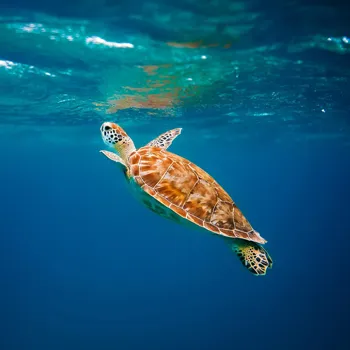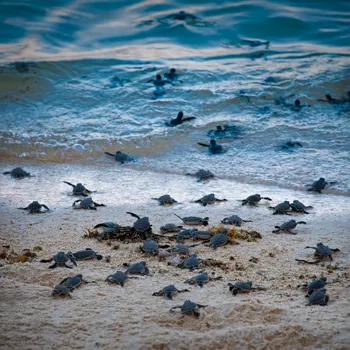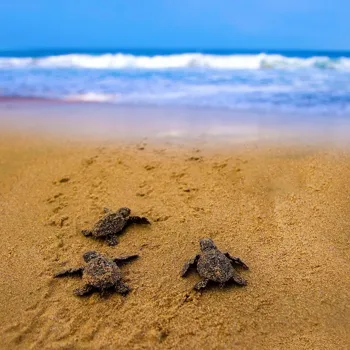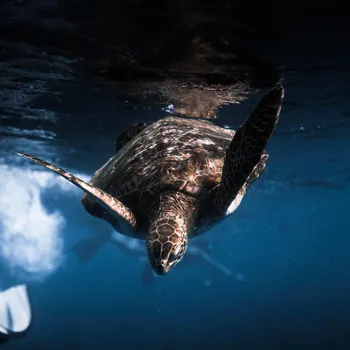Discover the incredible journey of the Olive Ridley Turtle: 7 facts that will astonish you. Explore their world and the challenges they face
The Olive Ridley turtle, a small sea turtle with a heart bigger
than the ocean, is a regular visitor to our Indian shores. Every year, thousands of these creatures embark on an epic journey to nest on our beaches, a sight that truly humbles and inspires.

But how much do we really know about these amazing reptiles? Prepare to be amazed as we uncover 7 incredible facts about the Olive Ridley turtle, revealing the secrets behind their survival and the challenges they face.
These facts highlight their unique behaviour, their vital role in the ocean ecosystem, and why it’s so crucial to protect them for generations to come. Their story is not just about turtles; it's about our shared planet and the responsibility we have to safeguard its biodiversity.
Olive Ridley turtles' arribada: mass nesting for survival
One of the most fascinating aspects of the Olive Ridley is their synchronized mass nesting, a phenomenon known as "arribada." Imagine tens of thousands of turtles emerging from the sea at the same time, covering the beach in a living carpet!

This spectacle, primarily observed in Odisha's Gahirmatha beach and some other locations, is believed to be a strategic adaptation to overwhelm predators. It ensures a greater number of eggs survive, boosting the chances of the species' continuation.
The sheer scale of the arribada is truly awe-inspiring, a testament to the power of nature and the Ridley's instinct for survival. This behaviour also shows how complex the world of animals is.
Olive Ridley turtles' vast migrations and navigation skills crucial for conservation
The vast distances these turtles travel are a major factor. As migratory creatures, the Olive Ridley undertakes substantial journeys across the oceans. Individuals born on the beaches of Odisha, for instance, may spend their adult lives foraging in the waters off Sri Lanka or even further afield!

Their amazing navigation skills are believed to be based on a combination of the Earth's magnetic field, celestial cues, and perhaps even a sense of smell.
Tracking these turtles through tagging and satellite telemetry has provided vital information about their migration routes and the threats they face across their range. This knowledge is essential for developing effective conservation strategies.
Olive Ridley's resilience in ocean survival and importance in oceanic health
The survival story of Olive Ridley is quite extraordinary. Despite their small size, Olive Ridleys are amazingly resilient creatures, able to withstand challenging ocean conditions and evade numerous predators.

They are primarily carnivorous, feeding on jellyfish, shrimps, crabs, and other invertebrates. However, their diet varies depending on their location and the availability of food. They are also opportunistic feeders, consuming whatever is readily available.
Their diet makes them very important for oceanic health. They are also affected by ocean pollution, so that poses a big threat to their health.
Olive Ridley turtle shell: armor for protection and storytelling
The shell of the Olive Ridley is a special piece of armour. The shell, or carapace, of the Olive Ridley is typically heart-shaped and ranges in color from olive green to grey. It provides protection against predators and physical damage.
The scutes, or bony plates, that make up the shell are surprisingly flexible, allowing the turtle to move freely. The shell is also covered in a layer of keratin, the same material that makes up our fingernails, which provides additional protection.
Their shells also tell stories about their travels. Scars and marks can reveal encounters with predators or obstacles they faced in the ocean.
Olive Ridleys face threats from human activities, need conservation efforts
Olive Ridleys are particularly vulnerable to threats from human activities. This includes entanglement in fishing nets, habitat destruction due to coastal development, and climate change.
Bycatch, the unintentional capture of marine animals in fishing gear, is a major cause of mortality for these turtles. Sea levels are rising and affecting the beach where they nest. The lights are also causing issues for them. Conservation efforts involve international collaborations.
They are implementing measures to reduce bycatch, protect nesting habitats, and raise awareness among local communities. The involvement of local communities is indeed most important.
Olive Ridley turtles face sex ratio threat due to climate change
The eggs of these turtles are quite unique. The eggs are soft and leathery, resembling ping-pong balls. They are incubated in the warm sand for about 45-65 days, after which the hatchlings emerge and make their way to the sea.
The temperature of the sand determines the sex of the hatchlings, with warmer temperatures producing more females and cooler temperatures producing more males.
This temperature-dependent sex determination makes Olive Ridleys vulnerable to the impacts of climate change, which could lead to skewed sex ratios and threaten the population's long-term viability. Their hatchlings are very small, so it is a very dangerous time for them.
AI Generated Content. Glance/InMobi shall have no liability for the content






![[WATCH] Arshdeep Singh hilariously mimics fan’s chant, leaves Yashasvi Jaiswal in splits](https://g-mob.glance-cdn.com/public/fc/images/f-a270977e8f-32db38b4-7334-583b-b07a-a3d2963849d2-b.webp)






